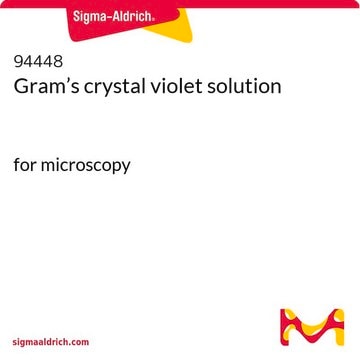61135
Crystal violet
for microscopy (Bact., Bot., Hist., Vit.), indicator (pH 0.1-2.0)
Synonyme(s) :
Chlorure d’hexaméthylpararosaniline, Violet 3 de base, Violet de gentiane, Violet de méthyle 10B
About This Item
Produits recommandés
Qualité
for microscopy (Bact., Bot., Hist., Vit.)
indicator (pH 0.1-2.0)
Niveau de qualité
Forme
powder
Couleur
green to very dark green
visual transition interval
0.1-2.0, yellow-green to blue-violet
Pf
205 °C (dec.) (lit.)
Densité
1.190 g/cm3
ε (coefficient d'extinction)
≥1750 at 585-595 nm in water
Adéquation
suitable for microscopy (Bact., Bot., Hist., Vit.)
Spectre d'activité de l'antibiotique
fungi
Application(s)
diagnostic assay manufacturing
hematology
histology
Mode d’action
cell membrane | interferes
enzyme | inhibits
Température de stockage
room temp
Chaîne SMILES
[Cl-].CN(C)c1ccc(cc1)\C(c2ccc(cc2)N(C)C)=C3/C=C\C(C=C3)=[N+](/C)C
InChI
1S/C25H30N3.ClH/c1-26(2)22-13-7-19(8-14-22)25(20-9-15-23(16-10-20)27(3)4)21-11-17-24(18-12-21)28(5)6;/h7-18H,1-6H3;1H/q+1;/p-1
Clé InChI
ZXJXZNDDNMQXFV-UHFFFAOYSA-M
Vous recherchez des produits similaires ? Visite Guide de comparaison des produits
Catégories apparentées
Description générale
Application
- Crystal violet is mainly used in Gram staining and its variants, and for staining amyloid, bacterial components, and vascular plant tissues.
- It is used in polychrome staining of epoxy resin sections, viability staining of cultured neurons, and confocal optical sectioning to analyze meiotic structures.
- It is also employed in the acridine orange-crystal violet staining of intracellular bacteria, microsporidian spores, and cytological smears.
Actions biochimiques/physiologiques
Principe
Mention d'avertissement
Danger
Mentions de danger
Conseils de prudence
Classification des risques
Acute Tox. 4 Oral - Aquatic Acute 1 - Aquatic Chronic 1 - Carc. 1B - Eye Dam. 1 - Muta. 2
Code de la classe de stockage
6.1C - Combustible acute toxic Cat.3 / toxic compounds or compounds which causing chronic effects
Classe de danger pour l'eau (WGK)
WGK 3
Point d'éclair (°F)
Not applicable
Point d'éclair (°C)
Not applicable
Équipement de protection individuelle
Eyeshields, Faceshields, Gloves, type P3 (EN 143) respirator cartridges
Choose from one of the most recent versions:
Déjà en possession de ce produit ?
Retrouvez la documentation relative aux produits que vous avez récemment achetés dans la Bibliothèque de documents.
Les clients ont également consulté
Notre équipe de scientifiques dispose d'une expérience dans tous les secteurs de la recherche, notamment en sciences de la vie, science des matériaux, synthèse chimique, chromatographie, analyse et dans de nombreux autres domaines..
Contacter notre Service technique








